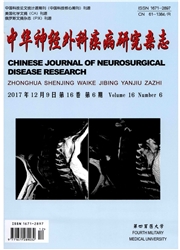

 中文摘要:
中文摘要:
目的通过建立小鼠创伤性脑损伤(TBI)模型,研究丝裂原活化蛋白激酶(MAPKs)通路中的细胞外调节蛋白激酶1/2(ERK1/2)通路、JNK通路和p38通路的激活及在TBI中的作用及机制。方法建立小鼠TBI模型,通过Westernblot检测ERK1/2、JNK和p38的相对磷酸化水平,确定TBI后MAPK通路的激活情况;分别加入ERK1/2通路抑制剂(PD98059,500μmol/L)、JNK通路抑制剂(SP600125,500μmol/L)和p38通路抑制剂(SB203580,500μmol/L),通过脑干湿重检测、神经功能学评分和TUNEL染色评估不同抑制剂对TBI的作用,并通过Westernblot检测ERK1/2、JNK和p38的相对磷酸化水平,明确ERK1/2通路、JNK通路和p38通路之间的相互调节作用。结果TBI可分别引起ERK1/2通路、JNK通路和p38通路的激活;抑制ERK通路和JNK通路可减轻TBI引起的脑水肿、神经功能损伤和细胞凋亡,而抑制p38通路则加重TBI引起的脑水肿、神经功能损伤和细胞凋亡;抑制JNK通路可减少ERK1/2的相对磷酸化水平,而抑制p38通路可增加ERK1/2的相对磷酸化水平。结论TBI后,ERK1/2通路和JNK通路的激活发挥促进损伤形成的作用,而p38通路的激活则起到神经保护的作用;ERK1/2通路的激活受到JNK通路的促进和p38通路的抑制,表明MAPK通路之间存在相互调节。
 英文摘要:
英文摘要:
Objective To investigate the effect of mitogen-activated protein kinases (MAPK) pathways such as extracellular regulated protein kinases1/2 (ERK1/2) pathway, JNK pathway, and p38 pathway on traumatic brain injury (TBI) by using in vivo TBI model. Methods After TBI, phosphorylation of ERK1/2, JNK, and p38 was detected by Western blot; effects of ERK1/2 pathway inhibitor (PD98059, 500 μmol/L), JNK pathway inhibitor (SP500125, 500μmol/L), and p38 pathway inhibitor (SB2ff5580, 590 μmol/L) on TBI were measured by water content detection, neurological severity score, and TUNEL assay and interactions between MAPK pathways were determined by Western blot. Results TBI differentially activated ERK1/2 pathway, iNK pathway, and p38 pathway; inhibition of ERK1/2 pathway or JNK pathway attenuated TBI-induced brain edema, neurological deficits, and apoptosis, while inhibition of p38 pathway aggravated TBI-induced brain edema, neurological deficits, and apoptosis; inhibition of JNK pathway reduced the relative phosphorylation of ERK1/2, whereas inhibition of of p38 pathway elevated the relative phosphorylation of ERK1/2. Conclusion After TBI, activation of ERK1/2 pathway and JNK pathway protnotes the formtion of brain edema, neurological deficits, and apoptosis, while activation of p38 pathway plays a ncuroprotective role in TBI; activation of ERK1/2 pathway is promoted by JNK pathway but inhibited by p38 pathway, indicating that there are interactions between different MAPK pathways.
 同期刊论文项目
同期刊论文项目
 同项目期刊论文
同项目期刊论文
 The microsurgical treatment of cranio-orbital tumors assisted by intraoperative electrophysiologic m
The microsurgical treatment of cranio-orbital tumors assisted by intraoperative electrophysiologic m Neuroprotective effect of osthole against acute ischemic stroke on middle cerebral ischemia occlusio
Neuroprotective effect of osthole against acute ischemic stroke on middle cerebral ischemia occlusio Protective Effects of mGluR5 Positive Modulators Against Traumatic Neuronal Injury Through PKC-Depen
Protective Effects of mGluR5 Positive Modulators Against Traumatic Neuronal Injury Through PKC-Depen Vascular Endothelial Growth Factor in Cerebral Ischemia (Retracted article. See vol. 90, pg. 1296, 2
Vascular Endothelial Growth Factor in Cerebral Ischemia (Retracted article. See vol. 90, pg. 1296, 2 Beneficial effects of hydrogen gas in a rat model of traumatic brain injury via reducing oxidative s
Beneficial effects of hydrogen gas in a rat model of traumatic brain injury via reducing oxidative s Neuroprotective effect of osthole on MPP+-induced cytotoxicity in PC12 cells via inhibition of mitoc
Neuroprotective effect of osthole on MPP+-induced cytotoxicity in PC12 cells via inhibition of mitoc Protective effect of Homer 1a on tumor necrosis factor-alpha with cycloheximide-induced apoptosis is
Protective effect of Homer 1a on tumor necrosis factor-alpha with cycloheximide-induced apoptosis is Interactions between SIRT1 and MAPK/ERK regulate neuronal apoptosis induced by traumatic brain injur
Interactions between SIRT1 and MAPK/ERK regulate neuronal apoptosis induced by traumatic brain injur Posttraumatic secondary brain insults exacerbates neuronal injury by altering metabotropic glutamate
Posttraumatic secondary brain insults exacerbates neuronal injury by altering metabotropic glutamate 期刊信息
期刊信息
